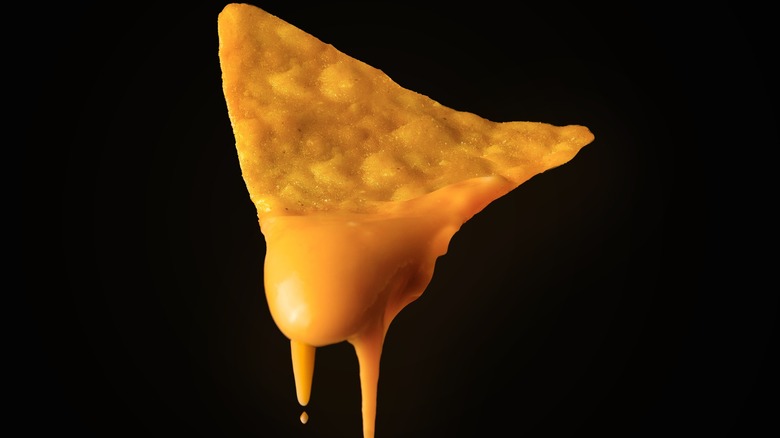The Key To Melting Cheese For The Ultimate Nachos
One element is essential for at-home nachos: perfectly melty cheese. Cheese that's like a sauce — think the oft-maligned movie theater nachos cheese cup but elevated. Knowing the melting point of your chosen cheese and bringing just the right amount of heat to the melting process will ensure the cheese doesn't turn into unusable glop.
All cheese contains fat, salt, water, and casein, which is milk protein. A high-moisture cheese melts at a lower temperature, so heat it just enough to kickstart the breakdown of casein, allowing mingling with the cheese's water and fat. When heating cheese for melting, use a food thermometer to check when the temperature reaches 90 degrees Fahrenheit. Keep stirring and heating the cheese evenly, gradually upping the temperature, but by no more than 50 degrees. The casein won't properly interact with the cheese's moisture and fat if it's heated too high or too quickly, leading to gross chunks of milk protein in your melt. That's why warming cheese in a microwave over some Tostitos just creates a grease slick.
When choosing the cheese to melt for nachos, consider the age and moisture level. An older, drier cheese like pecorino won't break down as easily in the melting process compared to something like the Gruyère used to top French onion soup. Once you have the melting basics down, utilizing a little food science in the form of sodium citrate will help achieve the ultimate saucy nacho cheese.
The best and worst cheeses to melt for nachos
The best cheeses for melting are those which have a high moisture content and aren't considered aged. An aged cheese is simply one that has ripened for a longer time, which brings out sharper flavors but makes the cheese drier. Because an aged cheese doesn't have as much water content as a younger one, it melts at a higher temperature. The higher the heat, the more risk of the milk proteins not fully dispersing with cheese's fat and moisture, leading to a tough mess.
Young, high-moisture cheeses that are good for nachos are mozzarella, Monterey Jack (plus its spicy cousins pepper Jack and queso blanco), and even a young cheddar cheese. Just make sure the cheddar isn't too sharp, i.e. aged and therefore drier. And that ballpark nacho cheese is so melty because processed cheeses, like American (and yes, American cheese is still a real cheese), are designed with additional moisture, meaning that they melt easily at even lower temperatures. Be sure to shred the cheese first for a faster and more even melt.
Conversely, the worst cheeses for that beautiful nacho sauce melt are aged, drier varieties. This includes cheeses typically grated or crumbled on top of finished dishes, such as Parmesan, blue cheese, aged Gouda, and Romano.
The salt that helps melt nacho cheese
Now that you're comfortable with melting cheese, upgrade that sauce with the addition of sodium citrate. Sodium citrate is the salt result of combining citric acid and sodium bicarbonate, which makes it sour. It's called a melting salt because it actively encourages the melting process. Sodium citrate helps the casein in cheese integrate with the moisture and fat, ensuring the resulting cheese sauce won't break into oily clumps.
Sodium citrate can be purchased ready-made, but it's also easy to replicate at home. Simply combine about 1.5 fluid ounces of lemon juice with half a teaspoon of baking soda in water. This reaction will only take a few minutes to happen. Once the foamy bubbles have died down, you'll be left with sodium citrate. Keep the temperature on the low side, add your young, shredded cheese, and stir your way to a perfect melt.
Feel free to experiment with melting different cheeses with sodium citrate to determine what cheeses will work for nachos in your kitchen. Remember to be aware of the cheese's age and moisture content when selecting, and to heat younger cheeses low and slow for that perfect nacho cheese sauce.


